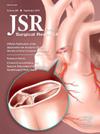Factors Associated With Readmissions Following Left Ventricular Assist Device Implantation
IF 1.8
3区 医学
Q2 SURGERY
引用次数: 0
Abstract
Introduction
While left ventricular device implantation has been shown to improve both survival and quality of life in patients with end stage heart failure, these patients have a high rate of readmissions to the hospital. The incidence and factors associated with readmission are poorly characterized in the destination therapy population.
Methods
All patients who underwent HeartMate III left ventricular assist device therapy (LVAD) implantation at our facility from 2017 to 2023 were identified. Patients undergoing primary LVAD implantation were included. Primary outcome was readmission for any reason. Multivariable linear regression was utilized to identify predictors of readmissions.
Results
From 2017 to 2023, 151 primary LVAD implantations were performed with 12 (8.0%) perioperative moralities (defined as index implant hospitalization mortality). The 139 remaining patients suffered 456 separate readmissions with a median follow-up of 590 (303-1002) ds and a total follow-up of 270.7 patient-ys for a rate of 1.7 readmissions per patient-y. The most common cause of readmission was heart failure exacerbation (27.0%), major infection (17.8%), and major bleeding (13.6%). Patients who were readmitted within 6 mos were more likely to have New York Heart Association class III or IV symptoms compared to those who had not been readmitted 39.1% versus 11.8% versus 15%, P = 0.0008. On multivariable linear regression, increasing body mass index (P = 0.02), increased preoperative bilirubin (P = 0.04), and increased follow-up time (P < 0.01) were predictive of the need for readmissions.
Conclusions
Following LVAD implantation, readmissions within 6 mos of surgery are associated with worse functional status at 6 mos and 1 y postoperatively. Increased body mass index and preoperative bilirubin were associated with more frequent readmissions.
求助全文
约1分钟内获得全文
求助全文
来源期刊
CiteScore
3.90
自引率
4.50%
发文量
627
审稿时长
138 days
期刊介绍:
The Journal of Surgical Research: Clinical and Laboratory Investigation publishes original articles concerned with clinical and laboratory investigations relevant to surgical practice and teaching. The journal emphasizes reports of clinical investigations or fundamental research bearing directly on surgical management that will be of general interest to a broad range of surgeons and surgical researchers. The articles presented need not have been the products of surgeons or of surgical laboratories.
The Journal of Surgical Research also features review articles and special articles relating to educational, research, or social issues of interest to the academic surgical community.

 求助内容:
求助内容: 应助结果提醒方式:
应助结果提醒方式:


